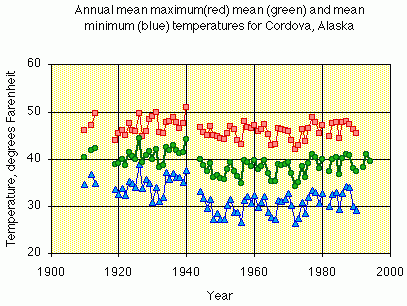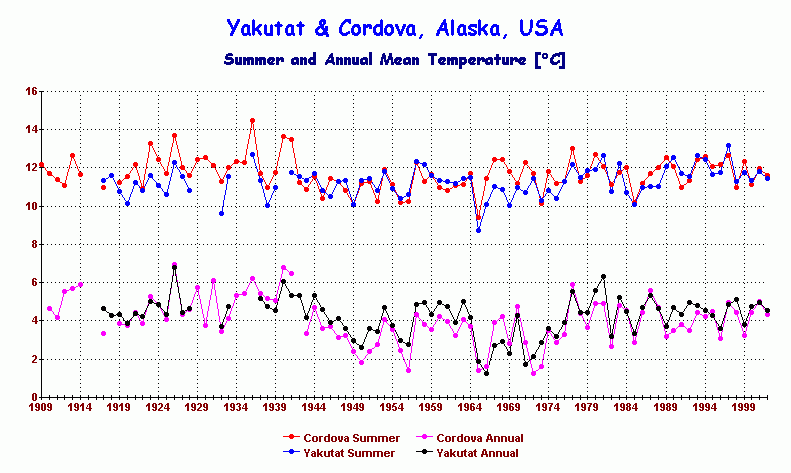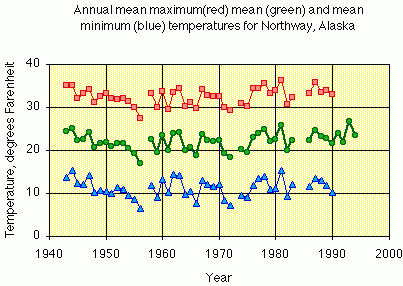Alaska's
Bering Glacier
Global Warming Meltdown?
by
John L. Daly
![]()
![]() In
July 1997, GreenPeace released their trumpeted report on the Arctic, and
media stations worldwide publicised TV video footage of an Alaskan glacier
in apparently serious trouble, with images of rapidly melting ice, icebergs
falling into the sea, and all blamed (of course) on global warming.
In
July 1997, GreenPeace released their trumpeted report on the Arctic, and
media stations worldwide publicised TV video footage of an Alaskan glacier
in apparently serious trouble, with images of rapidly melting ice, icebergs
falling into the sea, and all blamed (of course) on global warming.
![]() As
often in such matters, GreenPeace omit to tell the full story.
As
often in such matters, GreenPeace omit to tell the full story.
![]() The
Bering Glacier is located on the south coast of Alaska, facing the North
Pacific Ocean and is described as the world's "largest surging glacier".
That is, it periodically surges forward at very rapid rates (for a glacier),
travelling in May 1995 some 750 metres in only 2 weeks. With such rapid
surges, the ice mass flows into low warmer altitudes where the inevitable
end result is an equally rapid melting of the ice front. Several years
later, after the glacier front has receded, another surge takes place and
the cycle is repeated all over again.
The
Bering Glacier is located on the south coast of Alaska, facing the North
Pacific Ocean and is described as the world's "largest surging glacier".
That is, it periodically surges forward at very rapid rates (for a glacier),
travelling in May 1995 some 750 metres in only 2 weeks. With such rapid
surges, the ice mass flows into low warmer altitudes where the inevitable
end result is an equally rapid melting of the ice front. Several years
later, after the glacier front has receded, another surge takes place and
the cycle is repeated all over again.
![]() Of
course, if one witnesses only the melt-back phase of the cycle, it makes
for dramatic TV footage, easily fooling the less discriminating media outlets.
Of
course, if one witnesses only the melt-back phase of the cycle, it makes
for dramatic TV footage, easily fooling the less discriminating media outlets.
![]() While
some of the more sedate slow-moving glaciers may provide some clues as
to past and present climate change, a periodically `surging' glacier like
the Bering Glacier makes assessment of past climate change very problematic.
While
some of the more sedate slow-moving glaciers may provide some clues as
to past and present climate change, a periodically `surging' glacier like
the Bering Glacier makes assessment of past climate change very problematic.
![]() It
would be analogous to measuring mean sea level on a Hawaiian surfing beach
!
It
would be analogous to measuring mean sea level on a Hawaiian surfing beach
!
![]() If
the Bering or any other glacier was being affected by past or present climate
change, it could only change in response to the local
climate, not global climate directly. Global climate change may
well impact on local climates, but it is the local climates which the glaciers
must respond to, since it is these which condition the temperatures and
precipitation locally which cause the glacier to either expand or retreat.
If
the Bering or any other glacier was being affected by past or present climate
change, it could only change in response to the local
climate, not global climate directly. Global climate change may
well impact on local climates, but it is the local climates which the glaciers
must respond to, since it is these which condition the temperatures and
precipitation locally which cause the glacier to either expand or retreat.
![]() This
is where GreenPeace in their hurry to `prove' global warming impacting
on the Arctic neglected to mention what the local temperatures nearest
the Bering Glacier were doing, to back up their claims that the Bering
Glacier was being eroded by human-induced `global warming'.
This
is where GreenPeace in their hurry to `prove' global warming impacting
on the Arctic neglected to mention what the local temperatures nearest
the Bering Glacier were doing, to back up their claims that the Bering
Glacier was being eroded by human-induced `global warming'.
![]() We
can now correct that little oversight for them.
We
can now correct that little oversight for them.
![]() There
are three weather stations in the same general region as the Bering Glacier.
These are Cordova, 100 km to the west, Yakutak, 200 km to the east, both
on the Pacific coast either side of the glacier mass, and the third is
Northway, 300 km inland to the north. (Source is Alaska
Climate Research Center, all rights reserved)
There
are three weather stations in the same general region as the Bering Glacier.
These are Cordova, 100 km to the west, Yakutak, 200 km to the east, both
on the Pacific coast either side of the glacier mass, and the third is
Northway, 300 km inland to the north. (Source is Alaska
Climate Research Center, all rights reserved)
 |
As we can see, Cordova shows a fairly neutral trend since 1945, but was significantly warmer in the 1920s and 1930s. There is nothing in this record to suggest any significant or recent climate warming. It is also the closest record to the Bering Glacier itself. |
 |
Yakutat also shows a largely neutral trend overall, although there are greater variations present, such as the cold period in the late 1960s and early 1970s and the warm `spike' in 1980/81. But overall, there is nothing here to support the idea that there has been regional warming sufficient to affect glacier growth or retreat. Rather, changes in glacier patterns are most likely to be the result of precipitation rather than temperature changes. |
 |
Northway lies 300 km inland with data from 1942. It also shows a largely neutral trend. Unlike the other two which are close to the ocean, Northway gives an indication of inland temperatures, uninfluenced by the ocean. But even here, there is no trend worth noting. |
![]() Worldwide,
more stable glaciers do generally show some retreat. This is invariably
blamed on global warming, even though it is widely accepted that many such
glaciers have been in continuous retreat since the Little Ice Age of the
late 17th century. But even when glaciers advance (such as Norway's Eventyrisen
Glacier and New Zealand's Franz Josef Glacier a few years ago), that too
is blamed on global warming! When there is but a single agenda, any change,
whether too much wind, too little rain, heat waves, freezes, droughts,
floods, etc. all get blamed on global warming regardless whether the causal
mechanism involved makes any sense or not.
Worldwide,
more stable glaciers do generally show some retreat. This is invariably
blamed on global warming, even though it is widely accepted that many such
glaciers have been in continuous retreat since the Little Ice Age of the
late 17th century. But even when glaciers advance (such as Norway's Eventyrisen
Glacier and New Zealand's Franz Josef Glacier a few years ago), that too
is blamed on global warming! When there is but a single agenda, any change,
whether too much wind, too little rain, heat waves, freezes, droughts,
floods, etc. all get blamed on global warming regardless whether the causal
mechanism involved makes any sense or not.
![]() Glacier
retreat this century is consistent with some global warming, but this in
turn is consistent with the greater solar activity in the latter half of
this century and with the `rebound' of global temperatures from the Little
Ice Age. The fact that many glaciers still advance, and that the Bering
Glacier made two major surges in the 1990s suggest that the background
global warming is very small this century, probably at the low end of the
IPCC `consensus' estimate, namely +0.3 deg. C.
Glacier
retreat this century is consistent with some global warming, but this in
turn is consistent with the greater solar activity in the latter half of
this century and with the `rebound' of global temperatures from the Little
Ice Age. The fact that many glaciers still advance, and that the Bering
Glacier made two major surges in the 1990s suggest that the background
global warming is very small this century, probably at the low end of the
IPCC `consensus' estimate, namely +0.3 deg. C.
![]() That
said, the GreenPeace videos of the Bering Glacier made for great TV drama,
even if it was hopelessly bad science.
That
said, the GreenPeace videos of the Bering Glacier made for great TV drama,
even if it was hopelessly bad science.
John L. Daly
![]()
Return to "Still Waiting For Greenhouse"